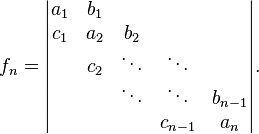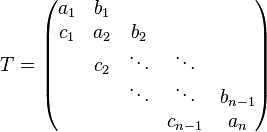Tridiagonal matrix
In linear algebra, a tridiagonal matrix is a matrix that has nonzero elements only on the main diagonal, the first diagonal below this, and the first diagonal above the main diagonal.
For example, the following matrix is tridiagonal:
The determinant of a tridiagonal matrix is given by the continuant of its elements.[1]
An orthogonal transformation of a symmetric (or Hermitian) matrix to tridiagonal form can be done with the Lanczos algorithm.
Properties
A tridiagonal matrix is a matrix that is both upper and lower Hessenberg matrix.[2] In particular, a tridiagonal matrix is a direct sum of p 1-by-1 and q 2-by-2 matrices such that p + q/2 = n -- the dimension of the tridiagonal. Although a general tridiagonal matrix is not necessarily symmetric or Hermitian, many of those that arise when solving linear algebra problems have one of these properties. Furthermore, if a real tridiagonal matrix A satisfies ak,k+1 ak+1,k > 0 for all k, so that the signs of its entries are symmetric, then it is similar to a Hermitian matrix, by a diagonal change of basis matrix. Hence, its eigenvalues are real. If we replace the strict inequality by ak,k+1 ak+1,k ≥ 0, then by continuity, the eigenvalues are still guaranteed to be real, but the matrix need no longer be similar to a Hermitian matrix.[3]
The set of all n × n tridiagonal matrices forms a 3n-2 dimensional vector space.
Many linear algebra algorithms require significantly less computational effort when applied to diagonal matrices, and this improvement often carries over to tridiagonal matrices as well.
Determinant
The determinant of a tridiagonal matrix A of order n can be computed from a three-term recurrence relation.[4] Write f1 = |a1| = a1 and
The sequence (fi) is called the continuant and satisfies the recurrence relation
with initial values f0 = 1 and f-1 = 0. The cost of computing the determinant of a tridiagonal matrix using this formula is linear in n, while the cost is cubic for a general matrix.
Inversion
The inverse of a non-singular tridiagonal matrix T
is given by
where the θi satisfy the recurrence relation
with initial conditions θ0 = 1, θ1 = a1 and the ϕi satisfy
with initial conditions ϕn+1 = 1 and ϕn = an.[5][6]
Closed form solutions can be computed for special cases such as symmetric matrices with all off-diagonal elements equal[7] or Toeplitz matrices[8] and for the general case as well.[9][10]
In general, the inverse of a tridiagonal matrix is a semiseparable matrix and vice versa.[11]
Solution of linear system
A system of equations A x = b for  can be solved by an efficient form of Gaussian elimination when A is tridiagonal called tridiagonal matrix algorithm, requiring O(n) operations.[12]
can be solved by an efficient form of Gaussian elimination when A is tridiagonal called tridiagonal matrix algorithm, requiring O(n) operations.[12]
Eigenvalues
When a tridiagonal matrix is also Toeplitz, there is a simple closed-form solution for its eigenvalues, namely
 ,
for
,
for  [13][14]
[13][14]
Computer programming
A transformation that reduces a general matrix to Hessenberg form will reduce a Hermitian matrix to tridiagonal form. So, many eigenvalue algorithms, when applied to a Hermitian matrix, reduce the input Hermitian matrix to tridiagonal form as a first step.
A tridiagonal matrix can also be stored more efficiently than a general matrix by using a special storage scheme. For instance, the LAPACK Fortran package stores an unsymmetric tridiagonal matrix of order n in three one-dimensional arrays, one of length n containing the diagonal elements, and two of length n − 1 containing the subdiagonal and superdiagonal elements.
See also
Notes
- ↑ Thomas Muir (1960). A treatise on the theory of determinants. Dover Publications. pp. 516–525.
- ↑ Horn, Roger A.; Johnson, Charles R. (1985). Matrix Analysis. Cambridge University Press. p. 28. ISBN 0521386322.
- ↑ Horn & Johnson, page 174
- ↑ El-Mikkawy, M. E. A. (2004). "On the inverse of a general tridiagonal matrix". Applied Mathematics and Computation 150 (3): 669–679. doi:10.1016/S0096-3003(03)00298-4.
- ↑ Da Fonseca, C. M. (2007). "On the eigenvalues of some tridiagonal matrices". Journal of Computational and Applied Mathematics 200: 283–286. doi:10.1016/j.cam.2005.08.047.
- ↑ Usmani, R. A. (1994). "Inversion of a tridiagonal jacobi matrix". Linear Algebra and its Applications. 212-213: 413–414. doi:10.1016/0024-3795(94)90414-6.
- ↑ Hu, G. Y.; O'Connell, R. F. (1996). "Analytical inversion of symmetric tridiagonal matrices". Journal of Physics A: Mathematical and General 29 (7): 1511. doi:10.1088/0305-4470/29/7/020.
- ↑ Huang, Y.; McColl, W. F. (1997). "Analytical inversion of general tridiagonal matrices". Journal of Physics A: Mathematical and General 30 (22): 7919. doi:10.1088/0305-4470/30/22/026.
- ↑ Mallik, R. K. (2001). "The inverse of a tridiagonal matrix". Linear Algebra and its Applications 325: 109–139. doi:10.1016/S0024-3795(00)00262-7.
- ↑ Kılıç, E. (2008). "Explicit formula for the inverse of a tridiagonal matrix by backward continued fractions". Applied Mathematics and Computation 197: 345–357. doi:10.1016/j.amc.2007.07.046.
- ↑ Raf Vandebril; Marc Van Barel; Nicola Mastronardi (2008). Matrix Computations and Semiseparable Matrices. Volume I: Linear Systems. JHU Press. Theorem 1.38, p. 41. ISBN 978-0-8018-8714-7.
- ↑ Golub, Gene H.; Van Loan, Charles F. (1996). Matrix Computations (3rd ed. ed.). The Johns Hopkins University Press. ISBN 0-8018-5414-8.
- ↑ Noschese, S.; Pasquini, L.; Reichel, L. (2013). "Tridiagonal Toeplitz matrices: Properties and novel applications". Numerical Linear Algebra with Applications 20 (2): 302. doi:10.1002/nla.1811.
- ↑ This can also be written as
 because
because  , as is done in: Kulkarni, D.; Schmidt, D.; Tsui, S. K. (1999). "Eigenvalues of tridiagonal pseudo-Toeplitz matrices". Linear Algebra and its Applications 297: 63. doi:10.1016/S0024-3795(99)00114-7.
, as is done in: Kulkarni, D.; Schmidt, D.; Tsui, S. K. (1999). "Eigenvalues of tridiagonal pseudo-Toeplitz matrices". Linear Algebra and its Applications 297: 63. doi:10.1016/S0024-3795(99)00114-7.
External links
- Tridiagonal and Bidiagonal Matrices in the LAPACK manual.
- Module for Tri-Diagonal Linear Systems
- Moawwad El-Mikkawy, Abdelrahman Karawia (2006). "Inversion of general tridiagonal matrices". Applied Mathematics Letters 19 (8): 712–720. doi:10.1016/j.aml.2005.11.012.
- High performance algorithms for reduction to condensed (Hessenberg, tridiagonal, bidiagonal) form
- Tridiagonal linear system solver in C++






